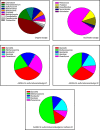Electricity from methane by reversing methanogenesis
- PMID: 28513579
- PMCID: PMC5442358
- DOI: 10.1038/ncomms15419
Electricity from methane by reversing methanogenesis
Abstract
Given our vast methane reserves and the difficulty in transporting methane without substantial leaks, the conversion of methane directly into electricity would be beneficial. Microbial fuel cells harness electrical power from a wide variety of substrates through biological means; however, the greenhouse gas methane has not been used with much success previously as a substrate in microbial fuel cells to generate electrical current. Here we construct a synthetic consortium consisting of: (i) an engineered archaeal strain to produce methyl-coenzyme M reductase from unculturable anaerobic methanotrophs for capturing methane and secreting acetate; (ii) micro-organisms from methane-acclimated sludge (including Paracoccus denitrificans) to facilitate electron transfer by providing electron shuttles (confirmed by replacing the sludge with humic acids), and (iii) Geobacter sulfurreducens to produce electrons from acetate, to create a microbial fuel cell that converts methane directly into significant electrical current. Notably, this methane microbial fuel cell operates at high Coulombic efficiency.
Conflict of interest statement
The authors declare no competing financial interests.
Figures



Similar articles
-
Methane as a Substrate for Energy Generation Using Microbial Fuel Cells.Indian J Microbiol. 2019 Mar;59(1):121-124. doi: 10.1007/s12088-018-0765-6. Epub 2018 Oct 19. Indian J Microbiol. 2019. PMID: 30728642 Free PMC article.
-
Electron carriers increase electricity production in methane microbial fuel cells that reverse methanogenesis.Biotechnol Biofuels. 2018 Jul 25;11:211. doi: 10.1186/s13068-018-1208-7. eCollection 2018. Biotechnol Biofuels. 2018. PMID: 30061933 Free PMC article.
-
Reversing methanogenesis to capture methane for liquid biofuel precursors.Microb Cell Fact. 2016 Jan 14;15:11. doi: 10.1186/s12934-015-0397-z. Microb Cell Fact. 2016. PMID: 26767617 Free PMC article.
-
Upflow anaerobic sludge blanket reactor--a review.Indian J Environ Health. 2001 Apr;43(2):1-82. Indian J Environ Health. 2001. PMID: 12397675 Review.
-
Biochemistry of methyl-coenzyme M reductase: the nickel metalloenzyme that catalyzes the final step in synthesis and the first step in anaerobic oxidation of the greenhouse gas methane.Met Ions Life Sci. 2014;14:125-45. doi: 10.1007/978-94-017-9269-1_6. Met Ions Life Sci. 2014. PMID: 25416393 Review.
Cited by
-
Methane as a Substrate for Energy Generation Using Microbial Fuel Cells.Indian J Microbiol. 2019 Mar;59(1):121-124. doi: 10.1007/s12088-018-0765-6. Epub 2018 Oct 19. Indian J Microbiol. 2019. PMID: 30728642 Free PMC article.
-
Electroactive Microorganisms in Advanced Energy Technologies.Molecules. 2023 May 26;28(11):4372. doi: 10.3390/molecules28114372. Molecules. 2023. PMID: 37298848 Free PMC article. Review.
-
Microbial Biofilms: Features of Formation and Potential for Use in Bioelectrochemical Devices.Biosensors (Basel). 2024 Jun 8;14(6):302. doi: 10.3390/bios14060302. Biosensors (Basel). 2024. PMID: 38920606 Free PMC article. Review.
-
Quorum quenching of autoinducer 2 increases methane production in anaerobic digestion of waste activated sludge.Appl Microbiol Biotechnol. 2022 Jun;106(12):4763-4774. doi: 10.1007/s00253-022-12014-w. Epub 2022 Jun 18. Appl Microbiol Biotechnol. 2022. PMID: 35715650
-
Multi-heme cytochrome-mediated extracellular electron transfer by the anaerobic methanotroph 'Candidatus Methanoperedens nitroreducens'.Nat Commun. 2023 Sep 30;14(1):6118. doi: 10.1038/s41467-023-41847-w. Nat Commun. 2023. PMID: 37777538 Free PMC article.
References
-
- Davis J. B. & Yarbrough H. F. Preliminary experiments on a microbial fuel cell. Science 137, 615–616 (1962). - PubMed
-
- Oh S., Min B. & Logan B. E. Cathode performance as a factor in electricity generation in microbial fuel cells. Environ. Sci. Technol. 38, 4900–4904 (2004). - PubMed
-
- Logan B., Cheng S., Watson V. & Estadt G. Graphite fiber brush anodes for increased power production in air-cathode microbial fuel cells. Environ. Sci. Technol. 41, 3341–3346 (2007). - PubMed
-
- Catal T., Li K., Bermek H. & Liu H. Electricity production from twelve monosaccharides using microbial fuel cells. J. Power Sources 175, 196–200 (2008).
Publication types
LinkOut - more resources
Full Text Sources
Other Literature Sources

